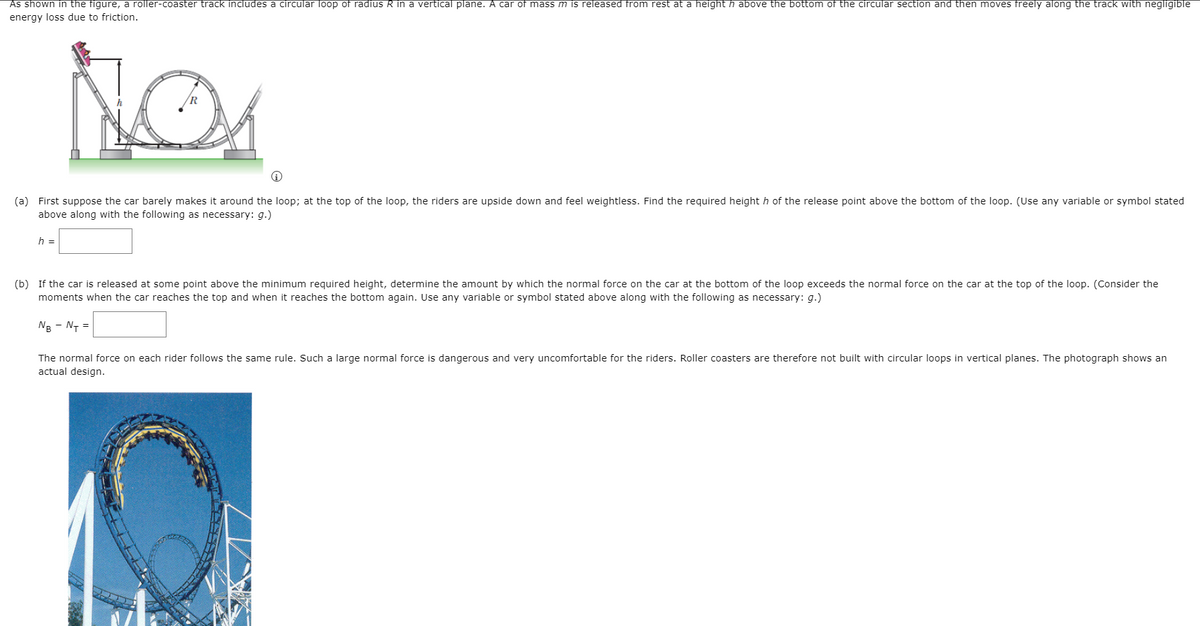shown in the figure, a roller-coaster track inciudes a circular loop of radius R in a vertical plane. A car of mass m is released from rest at a height h above the bottom of the circular section and then moves freely along the track with negligible energy loss due to friction. No (a) First suppose the car barely makes it around the loop; at the top of the loop, the riders are upside down and feel weightless. Find the required height h of the release point above the bottom of the loop. (Use any variable or symbol stated above along with the following as necessary: g.) h3= (b) If the car is released at some point above the minimum required height, determine the amount by which the normal force on the car at the bottom of the loop exceeds the normal force on the car at the top of the loop. (Consider the moments when the car reaches the top and when reaches the bottom again. Use any variable or symbol stated above along with the following as necessary: g.) Ng - N =
shown in the figure, a roller-coaster track inciudes a circular loop of radius R in a vertical plane. A car of mass m is released from rest at a height h above the bottom of the circular section and then moves freely along the track with negligible energy loss due to friction. No (a) First suppose the car barely makes it around the loop; at the top of the loop, the riders are upside down and feel weightless. Find the required height h of the release point above the bottom of the loop. (Use any variable or symbol stated above along with the following as necessary: g.) h3= (b) If the car is released at some point above the minimum required height, determine the amount by which the normal force on the car at the bottom of the loop exceeds the normal force on the car at the top of the loop. (Consider the moments when the car reaches the top and when reaches the bottom again. Use any variable or symbol stated above along with the following as necessary: g.) Ng - N =
Principles of Physics: A Calculus-Based Text
5th Edition
ISBN:9781133104261
Author:Raymond A. Serway, John W. Jewett
Publisher:Raymond A. Serway, John W. Jewett
Chapter7: Conservation Of Energy
Section: Chapter Questions
Problem 82P: A roller-coaster car shown in Figure P7.82 is released from rest from a height h and then moves...
Related questions
Topic Video
Question

Transcribed Image Text:As shown in the figure, a roller-coaster track includes a circular loop of radius R in a vertical plane. A car of mass m is released from rest at a height h above the bottom of the circular section and then moves freely along the track with negligible
energy loss due to friction.
(a) First suppose the car barely makes it around the loop; at the top of the loop, the riders are upside down and feel weightless. Find the required height h of the release point above the bottom of the loop. (Use any variable or symbol stated
above along with the following as necessary: g.)
h =
(b) If the car is released at some point above the minimum required height, determine the amount by which the normal force on the car at the bottom of the loop exceeds the normal force on the car at the top of the loop. (Consider the
moments when the car reaches the top and when it reaches the bottom again. Use any variable or symbol stated above along with the following as necessary: g.)
NB - N- =
The normal force on each rider follows the same rule. Such a large normal force is dangerous and very uncomfortable for the riders. Roller coasters are therefore not built with circular loops in vertical planes. The photograph shows an
actual design.
Expert Solution
This question has been solved!
Explore an expertly crafted, step-by-step solution for a thorough understanding of key concepts.
This is a popular solution!
Trending now
This is a popular solution!
Step by step
Solved in 2 steps with 1 images

Knowledge Booster
Learn more about
Need a deep-dive on the concept behind this application? Look no further. Learn more about this topic, physics and related others by exploring similar questions and additional content below.Recommended textbooks for you

Principles of Physics: A Calculus-Based Text
Physics
ISBN:
9781133104261
Author:
Raymond A. Serway, John W. Jewett
Publisher:
Cengage Learning

Physics for Scientists and Engineers, Technology …
Physics
ISBN:
9781305116399
Author:
Raymond A. Serway, John W. Jewett
Publisher:
Cengage Learning

College Physics
Physics
ISBN:
9781285737027
Author:
Raymond A. Serway, Chris Vuille
Publisher:
Cengage Learning

Principles of Physics: A Calculus-Based Text
Physics
ISBN:
9781133104261
Author:
Raymond A. Serway, John W. Jewett
Publisher:
Cengage Learning

Physics for Scientists and Engineers, Technology …
Physics
ISBN:
9781305116399
Author:
Raymond A. Serway, John W. Jewett
Publisher:
Cengage Learning

College Physics
Physics
ISBN:
9781285737027
Author:
Raymond A. Serway, Chris Vuille
Publisher:
Cengage Learning

College Physics
Physics
ISBN:
9781305952300
Author:
Raymond A. Serway, Chris Vuille
Publisher:
Cengage Learning

University Physics Volume 1
Physics
ISBN:
9781938168277
Author:
William Moebs, Samuel J. Ling, Jeff Sanny
Publisher:
OpenStax - Rice University

Physics for Scientists and Engineers: Foundations…
Physics
ISBN:
9781133939146
Author:
Katz, Debora M.
Publisher:
Cengage Learning